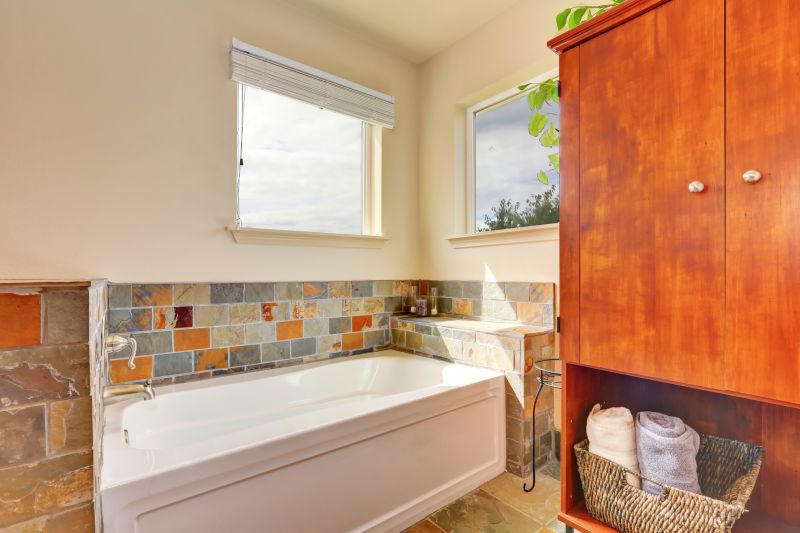Expert Picks For Bathtub Refinishings Supplies To Achieve Perfect Results
Get insights into the most reliable and effective products that help you refinish your bathtub with ease and confidence.
 Bathtub refinishing is a practical solution for revitalizing worn or outdated tubs without the need for full replacement. It involves applying specialized coatings that adhere to the existing surface, providing a fresh appearance and improved durability. This process can be an effective way to update a bathroom, especially when considering cost and time savings compared to traditional remodeling. Proper preparation and the right products are essential to achieve a smooth, long-lasting finish.
Bathtub refinishing is a practical solution for revitalizing worn or outdated tubs without the need for full replacement. It involves applying specialized coatings that adhere to the existing surface, providing a fresh appearance and improved durability. This process can be an effective way to update a bathroom, especially when considering cost and time savings compared to traditional remodeling. Proper preparation and the right products are essential to achieve a smooth, long-lasting finish.
Top Overall Option
High-Performance Refinishing Coating Kit
A comprehensive coating kit designed for both professionals and DIYers, offering a durable, smooth finish suitable for various bathtub surfaces. It includes primers, topcoats, and application tools, making the refinishing process more manageable and consistent.
Types of Products For Bathtub Refinishings
Epoxy Paints
Heavy-duty paints that provide a strong, water-resistant coating ideal for high-traffic tubs.
Acrylic Coatings
Flexible and easy-to-apply coatings that offer a smooth, glossy finish.
Spray-On Refinishing Kits
Convenient kits that allow for quick application with minimal mess, suitable for DIY projects.
Liquid Refinishing Coatings
Brush or roller-applied liquids that form a durable, seamless surface.
Urethane-Based Coatings
High-gloss finishes that resist chipping and staining when properly applied.
Two-Part Epoxy Systems
Mixed components that cure to form a robust, long-lasting surface.
Polyurethane Sealers
Protective sealers that enhance durability and shine after refinishing.
Bonding Primers
Primers formulated to improve adhesion of coatings to existing surfaces.
Textured Coatings
Products that add a non-slip or decorative texture to the bathtub surface.
Ceramic-Infused Coatings
Coatings with ceramic particles for increased heat resistance and durability.
Rapid-Dry Coatings
Products designed to cure quickly, reducing downtime during refinishing.
Eco-Resistant Coatings
Formulations that withstand frequent cleaning and exposure to moisture.
Anti-Microbial Coatings
Products that inhibit mold and mildew growth on the surface.
Self-Leveling Coatings
Coatings that flow out evenly for a smooth, uniform finish.
High-Gloss Finishes
Products that provide a shiny, mirror-like surface for aesthetic appeal.
Matte Finish Coatings
Non-reflective coatings offering a subdued, contemporary look.
Textured Spray Coatings
Spray products that create textured or decorative effects.
Popular Choices
Widely used for their durability and resistance, suitable for various bathtub surfaces.
Favored for their ease of application and glossy finish.
Popular for quick application and professional-looking results.
Known for their strong adhesion and long-lasting finish.
Chosen for their high-gloss appearance and chemical resistance.
Commonly used for detailed touch-ups and small refinishing jobs.
Often applied after initial coating to enhance durability.
Essential for ensuring proper adhesion, especially on slick surfaces.
Increasing in popularity due to their heat and stain resistance.
Preferred for projects requiring quick turnaround times.
Gaining popularity for their hygienic properties.
Valued for achieving smooth, professional finishes with minimal effort.
Chosen for modern, understated bathroom aesthetics.
Selected for decorative or functional textured effects.
The selection of refinishing products varies widely, from liquid coatings and epoxy paints to spray-on kits. Each type offers different application methods, drying times, and finishes, allowing homeowners and professionals to choose based on their specific needs and skill levels. It's important to consider the existing condition of the bathtub, the desired aesthetic, and the level of durability required when selecting a product.
Proper surface preparation is critical to ensure adhesion and longevity of the refinishing layer. This often involves cleaning, sanding, and sometimes etching the surface before applying the coating. Many products come with detailed instructions to guide users through the process, whether they are DIY enthusiasts or professional contractors. Using high-quality products and following best practices can result in a seamless, durable finish that enhances the bathroom's overall appearance.
In addition to coatings, there are various accessories and tools designed to facilitate the refinishing process. These include brushes, rollers, spray equipment, and primers. Selecting the right combination of products ensures a more uniform application and a professional-looking result. Regular maintenance and proper care after refinishing can extend the lifespan of the new surface, keeping the bathroom looking refreshed for years to come.
Key Buying Considerations
- Compatibility with existing bathtub material (fiberglass, acrylic, porcelain, etc.)
- Application method suitability (brush, roller, spray) based on skill level and project size
- Drying and curing times to plan project schedule effectively
- Desired finish type (glossy, matte, textured) for aesthetic preferences
- Durability and resistance to chipping, staining, or staining
- Ease of surface preparation required prior to application
- Compatibility with existing fixtures and fittings
- Availability of primers or bonding agents to ensure adhesion
- Shelf life and storage conditions of the product
- Cost considerations balanced with product quality
- User reviews and ratings for real-world performance insights
- Availability of technical support or instructions from the manufacturer
- Environmental considerations, such as VOC content (if applicable)
- Post-application maintenance requirements
- Compatibility with additional protective coatings or sealers
